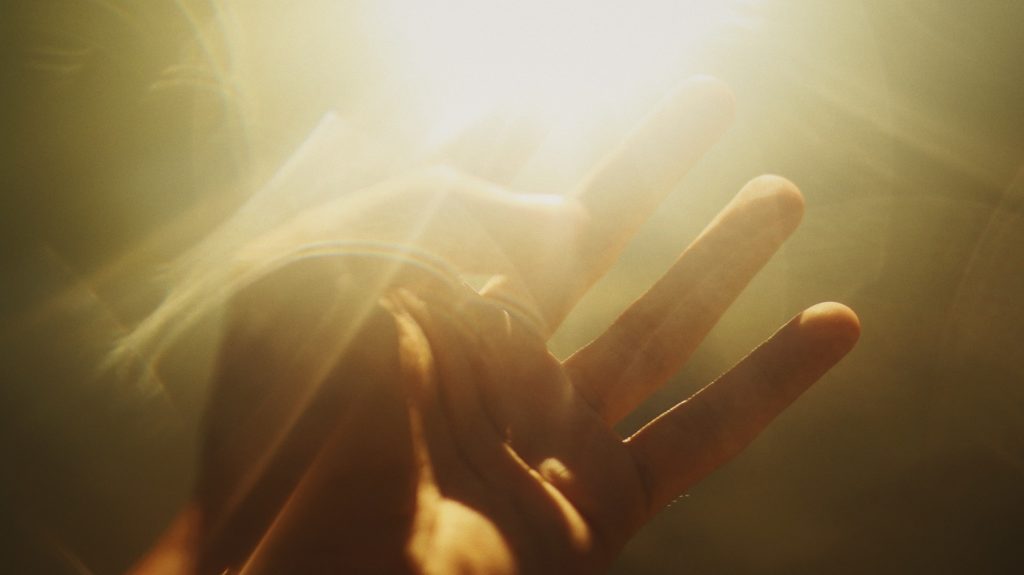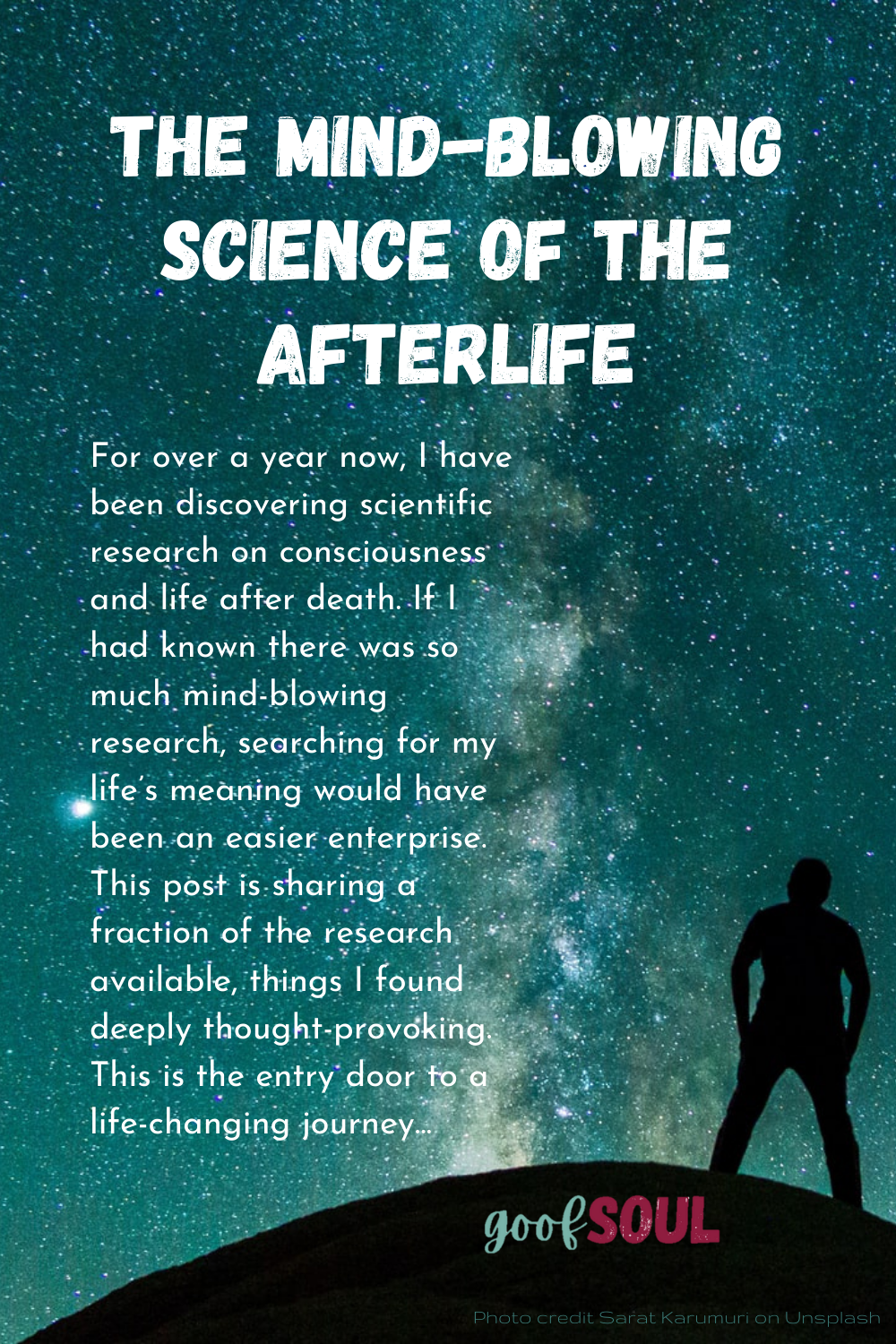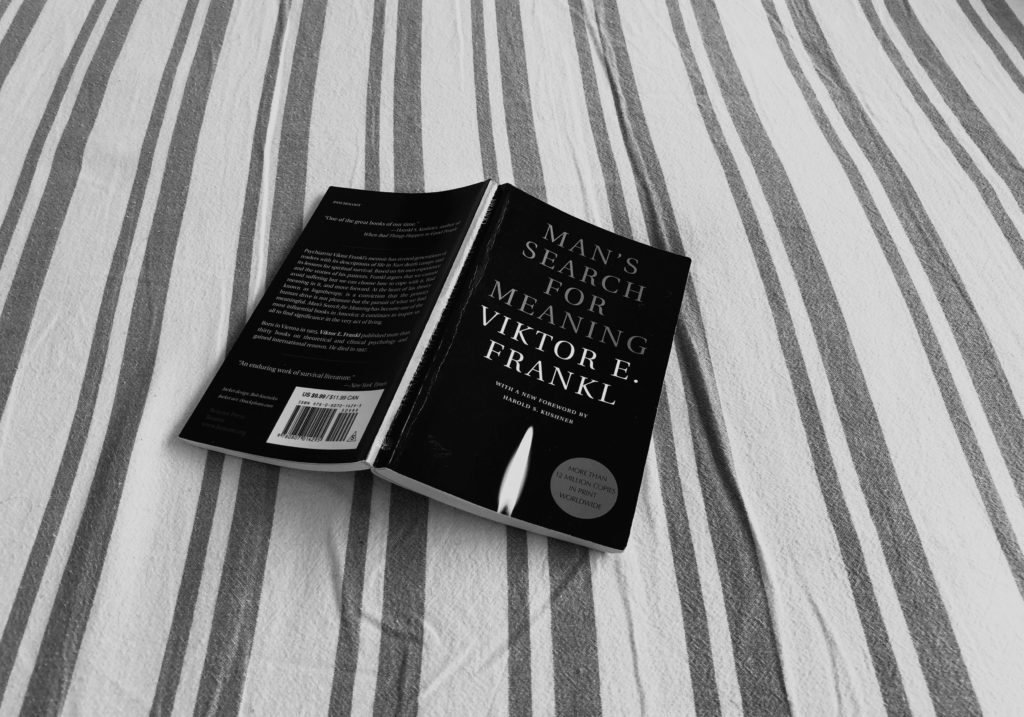
The mind-blowing science of the afterlife
For over a year now, I have been discovering scientific research on consciousness and life after death. Several things surprise me enormously: (1) there is a large amount of scientific evidence in favor of the afterlife and ‘paranormal’ activities related to it, (2) it is as rigorously tested as any other scientific field (if not more, due to the scrutiny it provokes), (3) it is not well-known or publicized because (4) skeptics in the scientific field are very loud and yet largely uninformed (or even unwilling to look at the data – which goes against every principle of science!). As I have come to realize, this topic is so intimate, so fundamental to our personal beliefs and our reasons for existence, it tends to be taboo and is often irrationally shut down.
My purpose with this post is to stimulate your curiosity, and in no way to provide the ultimate proof or pretend to be an expert in the field. I have wondered my entire life about life’s meaning, about spirituality and religions, and about why we are here, what is the point of suffering, how to hold on to life when death is inevitable (our own death, and of our loved ones), … Life is quite gloomy and anxiety-provoking when you wrestle with these big existential questions. This is something I talked about here. If I had known there was so much mind-blowing research, and I didn’t need to rely on organized religions or woo-woo hippie theories, searching for my life’s meaning would have been an easier enterprise. But then maybe I was meant to go through those struggles to then be able to help others with the same?
This post is going to be different than previous ones, as I will provide many and mostly quotations from renowned scientists, extracted from (or referencing) peer-reviewed scientific publications. The point is to show you this is not about personal opinions or beliefs, but sound material you should further explore for yourself. And of course, this is just a fraction of the research available, just things I stumbled upon and that I found deeply thought-provoking. This is the entry door to a life-changing journey…

The aferlife studied by parapsychology
Let’s discover what Etzel Cardeña has to say about parapsychology. But first, who is he? According to Wikipedia, he is “the Thorsen Professor of Psychology at Lund University, Sweden where he is Director of the Centre for Research on Consciousness and Anomalous Psychology (CERCAP). He has served as President of the Society of Psychological Hypnosis, and the Society for Clinical and Experimental Hypnosis. He is the current editor of the Journal of Parapsychology. He has expressed views in favour of open scientific enquiry and the validity of some paranormal phenomena. The Parapsychological Association honored Cardena with the 2013 Charles Honorton Integrative Contributions Award.” More on him here.
Here are some extracts of his article “The Experimental Evidence for Parapsychological Phenomena: A Review”, published in 2018 by the American Psychologist.
“This article presents a comprehensive integration of current experimental evidence and theories about so-called parapsychological (psi) phenomena. Throughout history, people have reported events that seem to violate the common-sense view of space and time. Some psychologists have been at the forefront of investigating these phenomena with sophisticated research protocols and theory, while others have devoted much of their careers to criticizing the field.” (p.663)
“The evidence provides cumulative support for the reality of psi, which cannot be readily explained away by the quality of the studies, fraud, selective reporting, experimental or analytical incompetence, or other frequent criticisms. The evidence for psi is comparable to that for established phenomena in psychology and other disciplines, although there is no consensual understanding of them.” (p.663)
“An informed psi skeptic wrote, “Most psychologists could reasonably be described as uninformed skeptics—a minority could reasonably be described as prejudiced bigots—where the paranormal is concerned” (French, 2001, p. 7).” (p.663)
“Parapsychology can be defined as the study of purported psi phenomena using the scientific method, and the Parapsychological Association, the professional association of the field, has been an affiliate of the American Association for the Advancement of Sciences (the world’s largest general scientific society) since 1969.” (p.664)
“At its inception, psychology and parapsychology were not clearly distinct disciplines, and foundational figures of the former also supported the latter (Cardeña, 2015a; Sommer, 2013. They include Bekhterev, Hans Berger (inventor of the electroencephalogram), Binet, Fechner, Sigmund Freud, Luria, Ramón y Cajal, and American Psychological Association (APA) presidents William James and Gardner Murphy. More recently, faculty from top-ranked universities such as Harvard, Princeton, and Stanford, including a past APA president, endorsed continuing research on psi (Cardeña, 2014).
Parapsychology has also contributed to methods and subject areas later integrated into psychology, among them the first use of randomization along with systematic use of masking procedures (Hacking, 1988); the first comprehensive use of meta-analysis, in 1940 (Gupta & Agrawal, 2012); study preregistration since 1976 (Johnson, 1976); and pioneering contributions to the psychology of hallucinations, eyewitness reports, and dissociative and hypnotic phenomena” (p.664)
“psi research has initiated or developed rigorous procedural and analytical strategies that mainstream psychology adopted later, and psi research is more rigorous in, for instance, using masked protocols, than psychology in general and other fields (Watt & Nagtegaal, 2004). Also, psi research has changed its procedures in response to internal and external criticisms” (p.673)
So, hopefully, these extracts should give you a flavor of how serious and rigorous this domain is researched. Before going further, I want to introduce the Bigelow Institute for Consciousness Studies. “BICS was founded in June 2020 by aerospace entrepreneur Robert T. Bigelow to support research into both the survival of human consciousness after physical death and, based on data from such studies, the nature of the afterlife. […] One purpose of the BICS is to raise awareness among the public and within the scientific community of the importance and relevance of such an investigation. BICS hopes to provide a public service by drawing increasing attention to, and encouraging research into, this fundamental and timeless topic. We are seeking hard evidence “beyond a reasonable doubt” that takes us beyond religion or philosophy and provides a body of knowledge to be brought widely into the public arena that could be partially unifying in its impact on human awareness and culture.” I can’t recommend enough exploring their website, checking the impressive board of directors’ profiles (physician, molecular biologist, professor of philosophy, theoretical physicist, professor of statistics, professor of psychiatry).
This institute organized an essay contest in 2021 for scientists to participate: “One goal of the essay contest is to award contestants for writing papers that summarize the best evidence available for the survival of human consciousness after permanent bodily death.” Winners received large sums of prize money (in total, almost 2 million USD). 204 essays were submitted; it took 4 months for the judges to select the best ones. And importantly, the top 29 essays are available for free on the website. These are accessible reads even if you are not an academic! Go read them, really! Some of the extracts below come from the top 4 winning essays.

Near-Death Experiences
A near-death experience (NDE) can happen to people who are in life-threatening conditions, such as accidents, illness (e.g. in a coma), under full anesthesia, under cardiac arrest, etc. Not all people who have unfortunate life-threatening circumstances will experience an NDE, but a large amount do. These NDEs are sufficiently reported, and give us glimpses of our consciousness being something separate from our brain and our body.
John C. Hagan, III, MD is an awarded ophthalmologist, medical researcher, and editor of Missouri Medicine medical journal and a medical textbook “The Science of Near-Death Experiences” (Missouri University Press, 2017). In his article in the Missouri Medicine journal, published in March-April 2015, titled “Near-Death Experiences: I Hope You Are Comfortable With Them By Now!”, he refers to several pieces of research. Here are some gems I found in this article:
“The NDE typically includes many of the following: the mind leaving the body and travelling upward; passing from dark to a brilliant light often within a tunnel. The light which is often interpreted to be God or the Supreme Being is ineffable and transmits joy, peace, love, comfort. They meet with deceased loved ones, friends, relatives that welcome them. They have a life review in which they understand the meaning of their life and how they have lived it and how it affected others. They never wish to leave this unity with the light source of love. They return to our mortal life they say reluctantly to help those needing them on earth or sometimes involuntarily because “your time has not yet come.” Upon returning to their earthly body most live a more purposeful, love-filled life. Thereafter the fear of death is largely absent.”
“Bruce Greyson, MD, Professor at the University of Virginia School of Medicine and a Co-Founder of the International Association of Near-Death Studies (IANDS) in November/December 2013 reviewed postulated scientific explanations of NDE including: expectancy, birth memories, altered blood gasses, REM intrusion, toxic and/or metabolic hallucinations, neurochemistry and neuroanatomy phenomena without finding a definitive explanation for NDE. In addition to the positive aspects during and after a NDE he was the first to point out “distressing NDEs” which are disturbing, even terrifying to those that experience them. He also noted that most people that have NDEs are mentally healthy and that NDEs must not be confused or equated with depersonalization, dissociation, post-traumatic stress disorder or pathologic conditions such as Charles-Bonnet Syndrome.”
“Dean Radin, PhD, one of the foremost experts in using evidence and laboratory-based science to study NDE, reported these conclusions in January/February 2014, “With one exception, NDEs may be interpreted as unusual forms of hallucinations associated with the injured or dying brain. The exception involves perceptions described from vantage points outside the body that are later confirmed to be correct and could not have been inferred. Over a century of laboratory studies have investigated whether it is possible in principle for the mind to transcend the physical boundaries of the brain. The cumulative experimental database strongly indicates that it can. It is not clear that this implies the mind is separate from the brain but it does suggest that a comprehensive explanation for NDEs will require revisions to present scientific assumptions about the brain-mind relationship”.” (Dean Radin was also a finalist in the Bigelow contest)
“Jeffrey Long, MD, a Louisiana radiation oncologist, established the nonprofit Near Death Experience Research Foundation for collection, international reporting, and study from NDE people worldwide. Please visit their website www.nderf.org to understand how universal and cross-cultural the NDE experience is. In the September/October 2014 issue Long elaborates on nine lines of evidence that converge on the explanation that NDE cannot be scientifically explained at this time. Among the most impressive of these nine are factual reports of events that have occurred in the past, or did happen in the future, or that transpired during the person’s NDE that were physically remote and otherwise unknowable by the person. Other unaccountable events: totally blind individuals describing accurately vivid visual events during their resuscitation and also precise accounts from individuals that were having hypothermic surgery in which they had no pulse, no heart activity, no blood pressure and a flat EEG.” (Jeffrey Long is in the top 10 winners of the Bigelow contest)
“Eben Alexander, III, MD, former Harvard neurosurgeon, […] writes, “The truth is that the more we come to understand the physical workings of the brain, the more we realize it does not create consciousness at all. We are conscious in spite of our brain! The brain serves more as a reducing valve or filter, limiting pre-existing consciousness down to the trickle of the illusory ‘here-now’ in which we find ourselves in this physical realm.”

Here is what Jeffrey Mishlove, PhD (winner of the Bigelow contest) and Pim Van Lommel, MD (2nd in the Bigelow contest) have to say about NDEs:
“William James had an unusual ability to take the complex and make it simple. His theory – the brain is the filter, rather than the source of consciousness – is one of his powerful and easy to grasp ideas. At the same time there is substantial empirical research to reinforce this hypothesis. ” (Mishlove p.16)
“Pim van Lommel, a Dutch cardiologist and author of Consciousness Beyond Life: The Science of Near-Death Experience, describes controlled studies involving patients who experienced cardiac arrest in hospitals. Five independent studies have been published involving 562 patients who survived cardiac arrest. Between 10% and 20% reported having a near-death experience. Van Lommel reports that neither physiological nor psychological factors can account for their experience. This is contrary to the careless opinions offered by scoffers. “We know, during cardiac arrest, there is no brain function left. So, we would expect no conscious experience at all during cardiac arrest”.” (Mishlove p.22-23)
“Scientific research on NDE in survivors of cardiac arrest appears to provide evidence of a continuity of consciousness after physical death. Consciousness is eternal, and outside of space and time. Interestingly, across all times and in many cultures, people have been convinced that the essence of man, usually known as the soul, lives on after the death of the body.” (Van Lommel p.36)
Reincarnation
“The scientific studies on reincarnation have generally found that small children between the ages of two to four may spontaneously begin to speak about experiences they had in a previous life in many details, and usually with intense emotions and nightmares. The child nearly always describes his mostly violent death in a previous life. There have been many well-studied and quite convincing cases of reincarnation, even with birthmarks corresponding to burns, knife wounds, and other violent traumas that caused the death in a previous life. (Stevenson, 1997; Tucker, 2005)” (Van Lommel p.34)
“Ian Stevenson’s methodology: The University of Virginia, Department of Perceptual Studies, now has a database of over 2,500 individual cases in which young children report former life memories. In roughly 1,700 cases, the information led to the deceased previous person’s identification. We know these as solved cases.” (Mishlove p.33)

Psychics & Mediums
Let’s talk about someone who has been doing a lot of research on psychics & mediums. “Dr. Julie Beischel is the Director of Research at the Windbridge Research Center. She received her PhD in Pharmacology and Toxicology with a minor in Microbiology and Immunology from the University of Arizona and uses her interdisciplinary training to apply the scientific method to controversial topics. For over 15 years, Dr. Beischel has worked full-time studying mediums: individuals who report experiencing communication with the deceased and who regularly, reliably, and on-demand report the specific resulting messages to the living. Her studies began with testing the accuracy and specificity of the information reported by mediums during phone readings performed under controlled, more than double-blind laboratory conditions that address alternative explanations for the source of their statements such as fraud, cueing, and overly general information. This protocol optimizes the research environment while also maximizing experimental controls. Dr. Beischel has also examined mediums’ psychology, physiology, business practices, demographics, and experiences and published peer-reviewed journal articles and anthology chapters discussing these and the potential therapeutic application of mediumship readings during bereavement.”
Dr. Beischel started out as a skeptic, provoked by a personal event with a medium. She couldn’t understand how this person could know such precise details. She decided to investigate in the lab this phenomenon, to “eliminate conventional explanations, including cold reading, rater bias, experimenter cueing, and fraud” (see one of her publications here). Her methodology and procedures are so strict, it is virtually impossible to deny the selected mediums’ abilities to connect ‘somehow’ with the afterlife and/or access the clients’ past and future life events. Psychic-medium Laura Lynne Jackson talks about the study protocols she went through, being studied by Dr. Beischel – it’s fascinating – I talk about it here. Dr. Beischel is also the fourth finalist in the Bigelow contest. She also shares a very interesting research selection on her website.
Here are some extracts from her Bigelow contest essay:
“Based on the science described here, this is what we know:
1. Certain prescreened mediums can report accurate and specific information about the deceased under controlled laboratory conditions that address normal explanations for the source of the information they report.
2. The anomalous source of that accurate information must involve psi.
3. The two possibilities are that (a) they are communicating telepathically with the survived consciousnesses of deceased people (survival psi) or (b) they are using precognition, clairvoyance, or telepathy with the living to gather information about the deceased (somatic psi).
4. Twenty laboratory-tested mediums and over 100 self-identified mediums have reported that survival psi and psychic readings for the living (the surrogate for the somatic psi theory) feel different. Extensive qualitative and statistically significant quantitative phenomenological research supports their claims.
5. Quantitative findings from blinded readings performed by laboratory-tested mediums for deceased and living targets specifically demonstrated that, at the very least, love is experienced to a greater degree during mediumistic readings for the deceased compared to during psychic readings for the living.
Taken together, these facts provide the best available evidence for the survival of human consciousness after permanent bodily death. […] The most logical explanation for the collection of data described above is that people can survive the death of their bodies and can communicate with mediums.” (Beischel p.58-59)
“near the end of the 20th century, at the request of Congress and the CIA, evaluations were commissioned to assess the validity of psychic functioning. The findings were reported by University of California statistician Jessica Utts and published in 1995 (and republished in 2018; 56). Utts’ findings were:
Using the standards applied to any other area of science, it is concluded that psychic functioning has been well established. The statistical results of the studies examined are far beyond what is expected by chance. Arguments that these results could be due to methodological flaws in the experiments are soundly refuted. (56, p. 118)
Utts went on to suggest that, “There is little benefit in continuing experiments designed to offer proof, since there is little more to be offered to anyone who does not accept the current collection of data” (p. 119).” (Beischel p.34)

A solid legal case
In his essay earning him 3rd place at the Bigelow contest, Dr. Leo Ruickbie compares the amount of evidence that would be required in the legal system to be convincing enough. You can read about him on here.
“A common standard for deciding cases where the stakes are high – life after death would seem to qualify – is found in the legal system: it must be “beyond reasonable doubt.” The problem is, that like ‘extraordinary evidence,’ ‘reasonable doubt’ is a circular definition and law courts have conspicuously refused to define it.
In a rare attempt to make ‘reasonable doubt’ understandable to jurors, the Federal Judicial Center made the following instruction:
Proof beyond a reasonable doubt is proof that leaves you firmly convinced of the defendant’s guilt. There are very few things in this world that we know with absolute certainty, and in criminal cases the law does not require proof that overcomes every possible doubt.” (Ruickbie p.7)

“It has already been noted that the evidence for life after death would be sufficient to prove the case in a court of law. One of the earliest to do so was author John Vyvyan (1908–1975). Writing in 1966, he said “a jury might well be convinced of a life after death on the basis of these arguments.” Since then, researchers have amassed almost sixty years’ worth of additional evidence in every area concerned with life after death. If it were enough to convince a jury then, how much more so now?” (Ruickbie p.78)
Another interesting source of information comes from a retired lawyer and his wife psychologist who have been collecting evidence of the afterlife for over two decades on their website: “There is, without any doubt whatsoever, objective, repeatable, evidence for the existence of the afterlife. Retired lawyer Victor Zammit Ph.D states that the evidence collected would be accepted by the highest court in any civilized country.” Don’t just take his word for it, or mine, but dive in his (old-fashion-looking but nonetheless thorough) collection!
“The argument put forward does not rely on one piece of evidence, or one case, so if one case is found in error it does not derail the overall argument. In fact, for each area of evidence considered, many other cases could be brought forward if needed. […] the amount of evidence is not the problem – the problem is why we do not believe it.” (Ruickbie p.77)
Consciousness & the brain
“A relationship clearly exists between the physical brain and the mind/self/consciousness (what makes you you). When the brain is injured or damaged, the mind functions differently. However, this does not prove that the cells and chemicals of the brain make mind. Correlation does not equal causation. Alternatively, mind may be like a signal and the brain like an antenna. Without the antenna, the signal can still exist. This non-materialist concept fits just fine with what is currently known about perception, psychology, basic physiology, biology, geology, astronomy, sociology, fundamental physics, quantum physics, and relativity.
Thinkers like William James and Aldous Huxley have conceptualized the mind as being interpreted, limited, funneled, regulated, transmitted, mediated, transformed, received, guided, or arbitrated by the brain. In the 1995 OMNI article “Supposing something different:
Reconciling science and the afterlife,” astronomer David Darling explained, “The brain does not produce consciousness at all, any more than a television set creates the programs that appear on its screen”. Religious studies scholar Huston Smith used this engaging simile: “The brain breathes mind like the lungs breathe air”.” (Beischel p.6-7)
Final Thoughts & Implications
“The great Swiss psychiatrist Carl Gustav Jung addressed what he considers civilization’s primary ailment in his book, Modern Man in Search of a Soul. He wrote: “As a physician, I am convinced that it is hygienic – if I may use the word – to discover in death a goal towards which one can strive; and that shrinking away from it is something unhealthy and abnormal which robs the second half of life of its purpose.”
We hide from our own deepest identity when we postulate that consciousness is extinguished with the death of the body – resulting in a severe gap in our capacity for self-knowledge.” (Mishlove p.96)
If you have been a skeptic about spirituality, soul/consciousness, if for you, religions have been advertising only myths and legends… like it was for me… I hope the above will make you think twice, and possibly engage you on a quest to re-define what your existence means. Here are some questions to get you started:
- If our consciousness doesn’t die with the death of our body, if we reincarnate, what is the purpose of our existence in this body, in this era, in this specific life? and are we living up to it?
- If our loved ones who passed away are not entirely gone, how does it feel to know we have not lost them for eternity and that there could be ways to still communicate with them?
- If death (of our body) is not the end of our existence, but merely of this life, if we just change shape in a way, what do we make of this life?
So, how will this knowledge transform what you value in your life?
References and other resources:
- Cardeña, E. (2018). The experimental evidence for parapsychological phenomena: A review. American Psychologist, 73(5), 663–677. https://doi.org/10.1037/amp0000236
- Bigelow Institute for Consciousness Studies
1st winner – Jeffrey Mishlove – Essay – Website
2nd winner – Pim Van Lommel – Essay – Book
3rd winner – Leo Ruickbie – Essay – Website
4th winner – Julie Beischel – Essay – Website - Hagan III, J. C. (2015). Near-Death Experiences: I Hope You Are Comfortable With Them By Now!. Missouri Medicine, 112(2), 88. https://www.ncbi.nlm.nih.gov/pmc/articles/PMC6170059/
- Jeffrey & Jody Long’s Near Death Experience Research Foundation
- Victor and Wendy Zammit – A Lawyer Presents the Evidence for the Afterlife






